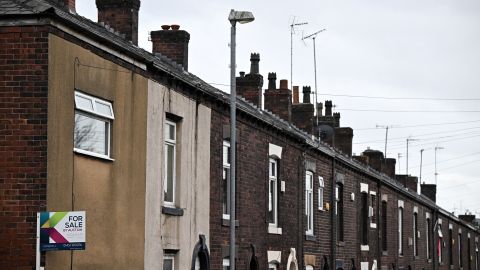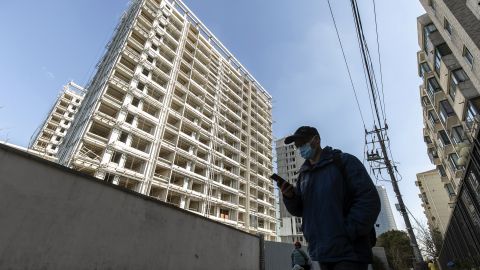A house price slump is coming. Rising unemployment could make it much worse
London
CNN Business
—
Last year, Auckland’s largest real estate company couldn’t sell properties quickly enough to meet demand in New Zealand’s biggest city.
Houses were “flying out the door,” said Grant Sykes, a manager at real estate agency Barfoot & Thompson. “There were chin-dropping moments when agents stand around the room and are gobsmacked at the prices being achieved,” he told CNN Business.
In one example, a property sold for 1 million New Zealand dollars ($610,000) above the asking price in an auction that lasted all of eight minutes. (Most homes in New Zealand are sold at auction.)
That was in May 2021, when sales attracted thousands of bidders who drove prices ever higher. Since then, Barfoot & Thompson’s clearance rate at auction has plummeted, according to Sykes, prolonging sales times and sending prices lower.
The time it takes to sell a property in New Zealand has increased by around 10 days on average since October 2021, according to the Real Estate Institute of New Zealand. Sales have plunged nearly 35{d4d1dfc03659490934346f23c59135b993ced5bc8cc26281e129c43fe68630c9} and median house prices are down 7.5{d4d1dfc03659490934346f23c59135b993ced5bc8cc26281e129c43fe68630c9} over the past year.

New Zealand is at the sharp end of a global housing market squeeze that has grim ramifications for the world economy.
The pandemic boom, which sent prices into the stratosphere, is running out of steam and house prices now are falling from Canada to China, setting the stage for the broadest housing market slowdown since the global financial crisis.
Rising interest rates are driving the dramatic change. Central banks on a warpath against inflation have taken rates to levels not seen for more than a decade, with ripple effects on the cost of borrowing.
US mortgage rates topped 7{d4d1dfc03659490934346f23c59135b993ced5bc8cc26281e129c43fe68630c9} last month for the first time since 2002, up from just over 3{d4d1dfc03659490934346f23c59135b993ced5bc8cc26281e129c43fe68630c9} a year ago, before pulling back slightly in November as inflation eased. In the European Union and United Kingdom, mortgage rates have more than doubled since last year, chasing would-be buyers from the market.
“Overall, this is the most worrying housing market outlook since 2007-2008, with markets poised between the prospect of modest declines and much steeper ones of 15{d4d1dfc03659490934346f23c59135b993ced5bc8cc26281e129c43fe68630c9}-20{d4d1dfc03659490934346f23c59135b993ced5bc8cc26281e129c43fe68630c9},” said Adam Slater, a lead economist at Oxford Economics, a consultancy.
One key factor determining how low prices go? Unemployment. A sharp increase in joblessness could lead to forced sales and foreclosures, “where steep discounts are common,” according to Slater.
But even if the correction in prices is mild, a housing market slowdown could have severe consequences because housing transactions in turn boost activity in other sectors of the economy.
“In an ideal world, you’ll get a bit of froth blown off the top [of house prices] and everything is fine. It isn’t impossible, but it’s more likely that housing downturns come with nastier consequences,” Slater told CNN Business.
House prices are already falling in more than half of the 18 advanced economies that Oxford Economics tracks, including the United Kingdom, Germany, Sweden, Australia and Canada, where prices dropped by around 7{d4d1dfc03659490934346f23c59135b993ced5bc8cc26281e129c43fe68630c9} from February to August.
“Data lags probably mean that most markets are now seeing falling prices,” said Slater. “We’re in the early period in quite a clear downturn now and the only real question is how steep and how long it’s going to be.”
House prices in the United States — which rose during the pandemic by the most since the 1970s — are falling too. Economists at Goldman Sachs expect a decline of around 5{d4d1dfc03659490934346f23c59135b993ced5bc8cc26281e129c43fe68630c9}-10{d4d1dfc03659490934346f23c59135b993ced5bc8cc26281e129c43fe68630c9} from the peak reached in June through to March 2024.
In a “pessimistic” scenario, US prices could plunge as much as 20{d4d1dfc03659490934346f23c59135b993ced5bc8cc26281e129c43fe68630c9}, Dallas Fed economist Enrique Martinez-Garcia wrote in a blog post recently.
Prices for new homes in China fell at the fastest pace in over seven years in October, according to official figures, reflecting a deepening property market slump that has gripped the country for months and is weighing heavily on its economy. Home sales have fallen by 43{d4d1dfc03659490934346f23c59135b993ced5bc8cc26281e129c43fe68630c9} this year, according to China Index Academy, a research firm.
Sales are sliding elsewhere too, as banks take a more cautious approach to lending and aspiring homebuyers delay purchases in the face of much higher borrowing costs and a deteriorating economic outlook.
House sales in Britain were 32{d4d1dfc03659490934346f23c59135b993ced5bc8cc26281e129c43fe68630c9} below the previous year’s level in September, according to official figures. A closely watched survey showed that new buyer inquiries fell for the sixth successive month in October to the lowest level since 2008, excluding the early months of 2020 when the market was largely shut because of the pandemic.
In the United States, sales of existing homes were down by more than 28{d4d1dfc03659490934346f23c59135b993ced5bc8cc26281e129c43fe68630c9} year-over-year in October, the ninth consecutive monthly decline, according to the National Association of Realtors.
Mortgage rates in 25 major cities around the world tracked by UBS have almost doubled on average since last year, making house purchases much less affordable.
“A skilled service sector worker can afford roughly one-third less housing space than before the pandemic,” according to the UBS Global Real Estate Bubble Index.

As well as putting off new buyers, the sharp increase in rates has shocked existing homeowners accustomed to more than a decade of ultra-low borrowing costs.
In Britain, more than 4 million mortgages have been issued to first-time buyers since 2009, when rates were near zero. “There’s a lot of people out there who don’t appreciate what it’s like when their monthly outgoings rise,” said Tom Bill, head of UK residential research at broker Knight Frank.
In countries with a larger share of variable rate mortgages, such as Sweden and Australia, the shock will be immediate and could increase the risk of forced sales that drive prices down faster.
But even in places where a large proportion of mortgages are fixed, such as New Zealand and the United Kingdom, the average maturity of these mortgages is quite short.
“This means much more debt will be subject to (often significantly) higher rates over the next year or so than might first appear to be the case,” Slater wrote in a report last month.
While interest rates have been the catalyst for the housing market slowdown, the jobs market will play a bigger role in determining how low prices ultimately plunge.
Modeling of past house price crashes by Oxford Economics shows that employment is the decisive factor in determining the severity of a downturn, because a spike in joblessness raises the number of forced sellers.
“History shows that if labor markets can remain strong, then the chances of a more benign correction are higher,” according to Innes McFee, chief global economist at Oxford Economics.
Employment levels in many advanced economies have recovered since falling at the start of the pandemic. But there are early signs that labor markets are starting to cool as weak economic growth hits demand for workers.
After recovering strongly at the beginning of the year, the number of hours worked was 1.5{d4d1dfc03659490934346f23c59135b993ced5bc8cc26281e129c43fe68630c9} below pre-pandemic levels in the third quarter, amounting to a deficit of 40 million full-time jobs, according to estimates by the International Labour Organization.
“The outlook for global labour markets has worsened in recent months and on current trends job vacancies will decline and global employment growth will deteriorate significantly in the final quarter of 2022,” the ILO said in an October report.
The unemployment rate in the United States ticked upwards in October to 3.7{d4d1dfc03659490934346f23c59135b993ced5bc8cc26281e129c43fe68630c9}. In the United Kingdom, job vacancies have fallen to the lowest level in a year. The UK Office for Budget Responsibility expects unemployment to rise by 505,000 to a peak of 1.7 million — an unemployment rate of 4.9{d4d1dfc03659490934346f23c59135b993ced5bc8cc26281e129c43fe68630c9} -— in the third quarter of 2024.
“A decisive increase in unemployment is a very big danger for housing markets,” said Slater of Oxford Economics.

Most market watchers are not expecting a repeat of the 2008 housing market crash. Banks and households are in better financial shape, and housing supply in some countries remains tight.
But even a modest a fall in house prices will knock confidence, causing homeowners to cut back on spending.
A slowdown in activity will also deal a blow to many other parts of the economy because of the housing market’s links to builders, lawyers, banks, moving companies and furniture stores, to name a few.
China’s property market accounts for about 28-30{d4d1dfc03659490934346f23c59135b993ced5bc8cc26281e129c43fe68630c9} of GDP because of these linkages. In the United States, housing’s broader contribution to GDP generally averages 15-18{d4d1dfc03659490934346f23c59135b993ced5bc8cc26281e129c43fe68630c9}, according to the National Association of Home Builders.
In a worst-case scenario — one in which house prices fall more sharply than anticipated and price declines are met with a slump in residential investment and tighter lending by banks — Oxford Economics forecasts that world GDP will expand by just 0.3{d4d1dfc03659490934346f23c59135b993ced5bc8cc26281e129c43fe68630c9} in 2023, rather than the 1.5{d4d1dfc03659490934346f23c59135b993ced5bc8cc26281e129c43fe68630c9} it currently expects.
“An additional negative factor, compared to the [global financial crisis], is that the Chinese housing market is also in a downturn,” according to Slater. “So rather than offsetting the impact on world output of a global housing downturn, as was the case after the GFC, the Chinese housing sector is contributing to the slump.”
— Laura He contributed to this report.